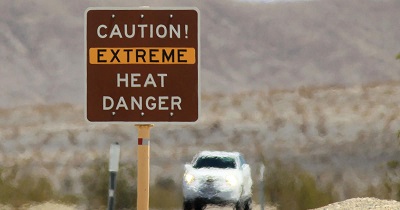Washington, (Asian independent) About a third of Americans have been in the grip of a brutal heatwave, with excessive heat warnings in effect in 15 states, from Washington and California on the West Coast down to Arizona, Texas and Florida in the south, impacting about 100 million Americans. And there are no signs of a let up. Not yet.
And there are areas that have seen unusually high rainfall and flooding as well.
“An extremely dangerous heatwave will build over the Southwest into the weekend, and likely peak in intensity on Sunday for much of the region. Dangerous heat may continue into next week for parts of the region,” said the US National Weather Service in a warning on Friday.
“All-time heat records could be approached or reached at some locations in the Southwest. This would be most likely on Sunday, and particularly in the San Joaquin Valley, Mojave Desert, and Great Basin regions. Phoenix is also likely to record its hottest week on record by seven-day average temperature,” it added.
Death Valley in California, which is called the heat capital of the world, is expected to cross 130-degree Fahrenheit (54.4-degree Celsius). Its worst was 134 F (56.6 C) in 1913.
Phoenix, meanwhile, which is said to be the most heat-prone city in America, established a record nighttime low of 94F on Wednesday and is poised to set numerous additional records.
Puerto Rico experienced its hottest month in more than 120 years in June, while Texas recorded its top 19 hottest days ever and parts of Michigan, New York and Vermont also broke their daily temperature records.
The Joe Biden administration has called the situation “alarming”, which it said in a fact-sheet released earlier this week, requiring an “all-of-society response”. It announced a slew of measures that included the establishment of two virtual research centres by the National Oceanic and Atmospheric Administration (NOA) to help communities manage and improve resilience to extreme heat.
The Biden administration has linked these high temperatures and the growing frequency with which they are being experienced to climate change as all other extreme weather occurrences.
But immediately, these severe heat conditions are attributed to what is called a “heat dome”. A heat dome is created when an unrelenting region of high pressure traps heat over over a particular area, and it can linger for days to weeks, the NOAA has said, adding that these domes are typically linked to the behaviour of the jet stream, which is a band of fast-moving winds high in the atmosphere that move in meandering wavelike patterns.
Severe heat is just one of the many extreme weather conditions experienced in the United States.
Tornadoes, hurricanes, flash floods, droughts, wildfires, blizzards, ice storms, Nor’easters, lake-effect snow, severe thunderstorms, hail, lightning and atmospheric rivers, derechos (long-lived, straight-line wind storm), dust storms, bomb cyclones (a fast-developing storm that occurs when atmospheric pressure drops at least 24 millibars over a 24-hour period) and the dreaded polar vortex (which are known to bring extreme cold weather) are the others.
Meanwhile, heavy rains pounded parts of the northeastern states of Pennsylvania, New York and Vermont at the same time as the southwestern parts were reeling under record heat. Many homes were flooded and drivers had to be rescued from vehicles stranded on flooded roadways.
West Point, home to the United States Military Academy, was under a flash flood emergency last Sunday, having already received 9 inches (23 cm) of rain.
“Another multi-day heavy rainfall event is expected tomorrow and Friday across portions of New England, where river and stream levels remain high,” the weather prediction center of the NOAA had written on Wednesday.
“A Day 2 Moderate Risk of Excessive Rainfall has been introduced over southern VT (Vermont), while a Day 3 Slight remains in effect for the region,” it added.
The risk for flash flooding was warned by the centre for parts of Arkansas and Louisiana, where a moderate risk for excessive rainfall is now in effect.








